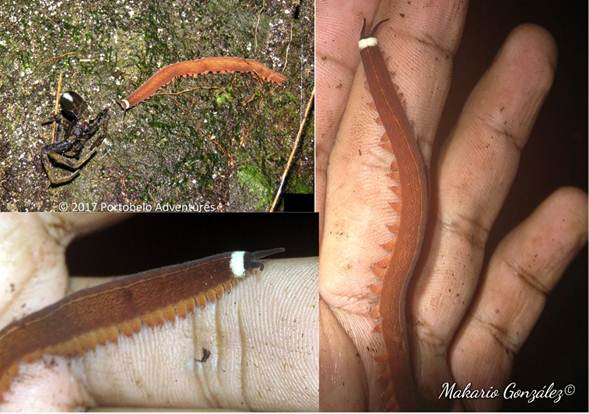Note
A velvet worm (Onychophora: Peripatidae) feeding on a free ranging spider in Sierra Llorona, Panama
Gusano de terciopelo (Onychophora: Peripatidae) alimentándose de una araña en Sierra Llorona, Panamá
Macario González1
Ángel Sosa-Bartuano2
Julián Monge-Nájera3
1Escuela de Biología, Facultad de Ciencias Naturales y Exactas, Universidad Autónoma de Chiriquí, David, Panamá; macariogonzp@gmail.com
2Colección Zoológica Dr. Eustorgio Méndez, Departamento de Investigación en Entomología Médica, Instituto Conmemorativo Gorgas de Estudios de la Salud, Ciudad de Panamá, Panamá; asosa2983@gmail.com
3Laboratorio de Ecología Urbana, Universidad Estatal a Distancia (UNED), 2050 San José, Costa Rica; julianmonge@gmail.com
Resumen
Los gusanos de terciopelo rara vez atacan a las arañas porque éstas son presas ágiles y peligrosas. Aquí informamos de un onicóforo comiendo una araña (posiblemente de la familia Ctenidae) en Sierra Llorona, Colón, Panamá (9,35863°-79,70287°; 491 msnm).
Palabras clave: invertebrados neotropicales; red adhesiva; reserva privada; selva tropical
Abstract
Onychophoran worms seldom attack spiders because spiders are agile and dangerous prey. Here we report an onychophoran feeding on a spider (possibly a Ctenidae) in Sierra Llorona, Colón, Panamá (9, 35863°-79,70287°; altitude 491 m).
Key words: Neotropical invertebrates; adhesive net; private reserve; tropical rainforest
Onychophoran worms are ancient predators that can only live in moist microhabitats and hunt for small invertebrates at night (mostly insects, myriapods, spiders and crustaceans, Read & Hughes, 1987; Monge-Nájera, Barrientos & Aguilar, 1993). However, many spiders are agile and dangerous to onychophorans, and probably they are not frequent prey (Read & Hughes, 1987; Dias & Lo-Man-Hung, 2009); furthermore, some spiders can kill and eat onychophorans (Franco & Monge-Nájera, 2016). Here we report an onychophoran feeding on a spider in Panama.
The observation was made on July 18, 2017, at 10:21 pm, in Sierra Llorona Private Reserve, Colón, Panama; 9,35863°-79,70287°; 491 masl; Premontane Very Moist Forest; precipitation: 3000 a 3500 mm (Autoridad Nacional del Ambiente de Panamá, 2010).
On a mossy rock at the edge of a creek, the first author found an onychophoran feeding on a spider, which was still moving its legs slowly ( Figure 1). That same night he saw four more onychophorans in understory vegetation, but none were feeding. The worm was about 7 cm long and the spider about 4cm long. For future reference, we propose the common name of "Sierra Llorona Leather-Brown Collared Onychophoran" for this species (Sosa-Bartuano, Monge-Nájera & Morera-Brenes, 2018).
The spider seemed to be a ctenid; the family Ctenidae has at least 16 species in Panama (Quintero, 2005). They do not build webs and include aggressive and poisonous species that hunt at night among soil vegetation. These are dangerous spiders and perhaps the onychophoran found a weakened individual and secured it with adhesive, but it is also possible that the worm killed a healthy spider thanks to its stealth hunting behavior (Morera-Brenes & Monge-Nájera, 2010).
We thank Diomedes Quintero and William Eberhard for information on the behavior and possible identity of the spider.
EDITED BY CAROLINA SEAS
References
Autoridad Nacional del Ambiente de Panamá. (2010). Atlas Ambiental de la República de Panamá. Panama: Gobierno de Panamá.
[ Links ]
Dias, S. C., & Lo-Man-Hung, N. F. (2009). First record of an onychophoran (Onychophora, Peripatidae) feeding on a theraphosid spider (Araneae, Theraphosidae). Journal of Arachnology, 37(1), 116-117. doi: 10.1636/ST08-20.1
[ Links ]
Franco, R., & Monge-Nájera, J. (2016). Inverted roles: Spider predation upon Neotropical velvet worms (Epiperipatus spp.; Onychophora: Peripatidae). UNED Research Journal, 8(2),171-173. doi: 10.22458/urj.v8i2.1557
[ Links ]
Monge-Nájera, J., Barrientos, Z., & Aguilar, F. (1993). Behavior of Epiperipatus biolleyi (Onychophora: Peripatidae) under laboratory conditions. Revista de Biología Tropical, 41(3 A), 689-696.
[ Links ]
Morera-Brenes, B., & Monge-Nájera, J. (2010). A new giant species of placented worm and the mechanism by which onychophorans weave their nets (Onychophora: Peripatidae). Revista de Biología Tropical, 58(4), 1127-1142. doi: 10.15517/rbt.v58i4.5398
[ Links ]
Quintero, D. (2005). Arácnidos. In: S. Castroviejo & A. Ibáñez(eds.). Estudios sobre la biodiversidad de la región de Bahía Honda (Veraguas, Panamá). Madrid: Consejo Superior de Investigaciones Científicas.
[ Links ]
Read, V. S. J., & Hughes, R. N. (1987). Feeding behaviour and prey choice in Macroperipatus torquatus (Onychophora). Proceedings of the Royal Society of London B: Biological Sciences, 230(1261), 483-506. doi: 10.1098/rspb.1987.0030
[ Links ]
Sosa-Bartuano, Á., Monge-Nájera, J., & Morera-Brenes, B. (2018). A proposed solution to the species problem in velvet worm conservation (Onychophora). UNED Research Journal , 10(1), 204-208. doi: 10.22458/urj.v10i1.2027
[ Links ]












 uBio
uBio 


